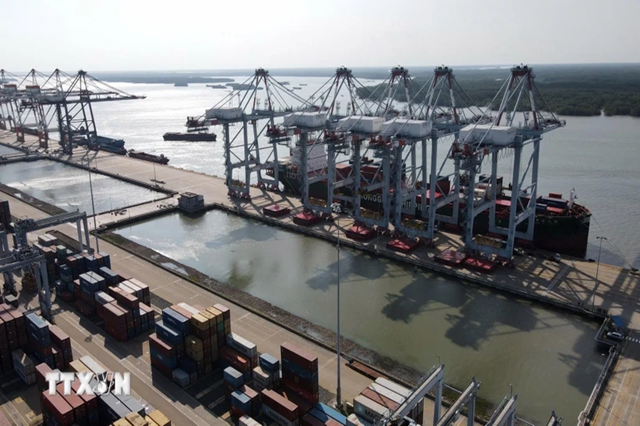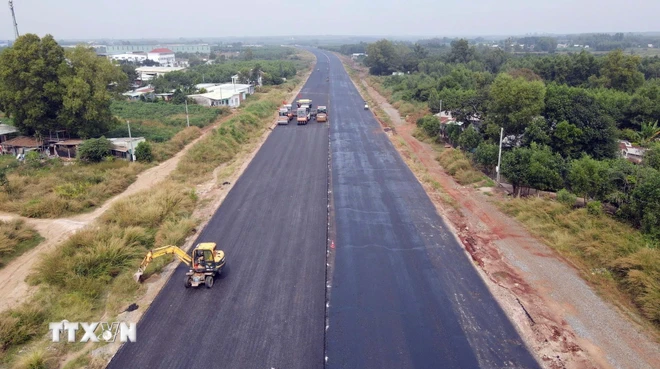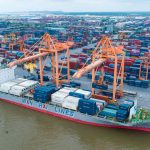The Cai Mep Port Cluster: Overcoming Challenges for a Brighter Future

A glimpse of the Cai Mep Port Cluster. (Photo: Doan Manh Duong/VNA)
|
The Cai Mep port cluster in Ba Ria-Vung Tau province has established its significance in the global maritime transport chain and plays a pivotal role in the socioeconomic development of southern Vietnam.
However, obstacles related to customs policies and mechanisms are hindering the cluster’s growth.
One of the main challenges is the concept of a “separate customs gate” for each port within the Cai Mep cluster. While the Master Plan for the Development of Vietnam’s Seaport System approved by the Prime Minister in Decision No. 1579/QD-TTg dated September 22, 2021, and adjusted in Decision No. 442/QD-TTg dated May 22, 2024, designates Cai Mep as a special seaport cluster, the Vietnamese customs law considers each port operated by a different business as a separate customs gate.
 Construction of the Bien Hoa-Vung Tau Expressway in Ba Ria-Vung Tau province. (Photo: Doan Manh Duong/VNA)
|
For a mother vessel operating at the Cai Mep cluster, this means that containers being transferred between ports within the cluster require a separate “Transport Declaration Form” with multiple “information fields” to be filled out, even though the information has already been provided to the Cai Mep Customs Office, which oversees the entire cluster.
Additionally, containers being transshipped must undergo resealing, despite already being sealed by the shipping line. These extra steps result in wasted time and effort for logistics companies and additional costs for cargo owners, while also requiring more manpower from the customs authorities.
Another challenge is the increasing demand for port changes by container vessels. As the volume of cargo handled by the Cai Mep cluster grows rapidly, the need for port changes arises due to various reasons, including insufficient berth capacity. According to current regulations, before a vessel enters a port, all cargo information must be declared on the “Cargo Manifest,” and any changes to the port of call require adjustments to this manifest, which can be a time-consuming process.
With an expected increase in vessel calls at the Cai Mep cluster, shipping lines would greatly benefit from flexible arrangements that allow them to change ports of call without incurring delays. This would enhance the overall efficiency of the cluster.
International ports with high transshipment volumes, such as Singapore, where transshipments account for 85% of its total cargo volume, provide valuable insights. Containers can move freely between the Pasir Panjang and Tuas ports, located more than 25 kilometers apart, without the need for separate transport declaration forms or resealing.
 Construction of the road leading to Phuoc An Bridge, connecting the Cai Mep- Thi Vai port road with Dong Nai province. (Photo: Doan Manh Duong/VNA)
|
Similar facilitative supervision mechanisms are in place at the Port of Busan in South Korea and Hong Kong, where multiple ports are operated by different companies, yet transshipment volumes remain high.
Recognizing these challenges, the Ba Ria-Vung Tau provincial authorities, port operators, and government agencies are working together to find solutions. The Cai Mep Customs Office has implemented special procedures for cargo transshipments between adjacent ports that have opened their gates for interconnection, such as TCIT and CMIT. However, a more comprehensive solution is needed to cover all ports within the cluster and attract more transshipment cargo.
The article also highlights the efforts to develop the Cai Mep Lower and Cai Mep Lower Lower ports, which will add significant capacity to the cluster. Additionally, the Can Gio International Container Port project, located opposite the Cai Mep cluster, is in the pre-feasibility study phase and will further enhance the region’s port infrastructure.
To realize the vision of making the Cai Mep cluster a leading international transshipment hub, it is essential to address the customs-related challenges. The province and relevant government agencies are working on drafting and amending decrees and circulars related to customs supervision, aiming to facilitate cargo transshipments between ports and vessel port changes within the same customs management area.
The implementation of an “open port” policy, leveraging technological advancements, is also being explored as a crucial step towards establishing a free trade area associated with the Cai Mep seaport, as outlined in Resolution No. 24-NQ/TW dated October 7, 2022, of the Politburo on socio-economic development and ensuring national defense and security in the Southeast region by 2030, with a vision towards 2050.
By overcoming these challenges and creating a more efficient and attractive environment for shipping lines and cargo owners, the Cai Mep port cluster is poised for even greater success in the future.
Doan Manh Duong
“CAAV: Keeping a Close Eye on Restructuring Airlines Bamboo Airways and Pacific Airlines”
On July 3, 2024, at a conference held by the Ministry of Transport to evaluate the first half of the year and deploy tasks for the next six months, Dinh Viet Thang, Director of the Vietnam Aviation Administration, reported that the total passenger market reached an estimated 38.1 million passengers in the first half of this year, a 6.7% increase compared to the same period in 2023.
New Year Messages Affirming a New Economic Growth Outlook
Many important messages about the direction of economic development and management have been affirmed at the beginning of the new year, signaling a new attitude for 2024.
Hai Phong Port Receives 27 Ships During Lunar New Year Week
According to Mr. Pham Hong Minh, Party Secretary, Chairman of the Board of Directors of Hai Phong Port Joint Stock Company, with the determination of all employees, Hai Phong Port maintains 24/7 production activities throughout the Tet holiday. During the Lunar New Year week of Giap Thin (from February 8th to February 14th), Hai Phong Port received 27 vessels, with a total output of approximately 417,000 tons.





















